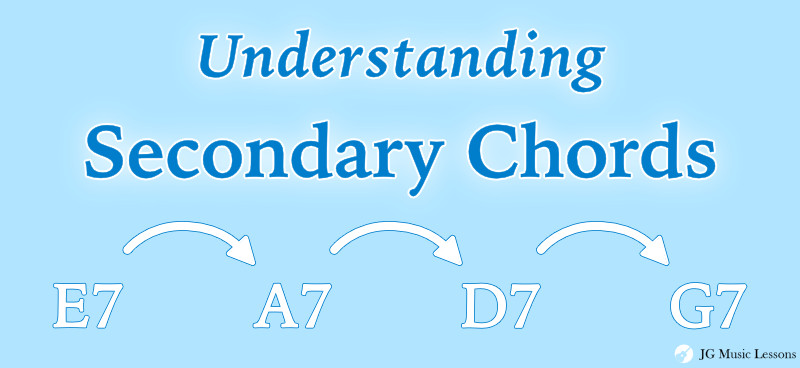If you’re interested in diving deeper into music theory and harmony, you’ll want to understand the concept of secondary chords. Secondary chords allow you to expand your palette of harmonic possibilities to create richer chord progressions for composition or improvisation.
This lesson covers the music theory on secondary chords and how to apply them in a chord progression. The examples at end include guitar chord charts but can they also apply to other instruments. Let’s get started!
What are secondary chords?
Secondary chords are chords that function as a 5 chord to resolve to any chord other than the tonic (1 chord). For example, in the key of C Major, the secondary chord to the 3 minor chord (E minor) would a B Major chord.

You can add a secondary chord before any other chord. To do this, simply think of a Major chord which is a 5th interval above the chord you’re landing to. For example, here are some secondary chords in the key of C Major:
- A Major is the 5 of the 2 chord (D minor)
- B Major is the 5 of the 3 chord (E minor)
- C Major is the 5 of the 4 chord (F Major)
- D Major is the 5 of the 5 chord (G Major)
- E Major is the 5 of the 6 chord (A minor)
- F# Major is the 5 of the 7 chord (B diminished).
Most secondary chords do not belong to the diatonic chords of a scale, which is why they add tension or suspense to create a much more interesting chord progression. However, these chords make sense within a progression because they have a specific function of resolving to the next chord.
If needed, see this other post to learn the related chords in Major and minor key signatures, also known as diatonic chords.
Secondary chords in Major keys chart
| Key center | 5 of 2 chord | 5 of 3 chord | 5 of 4 chord | 5 of 5 chord | 5 of 6 chord | 5 of 7 chord |
|---|---|---|---|---|---|---|
| C Major | A Major | B Major | C Major | D Major | E Major | F# Major |
| D Major | B Major | C# Major | D Major | E Major | F# Major | G# Major |
| E Major | C# Major | D# Major | E Major | F# Major | G# Major | A# Major |
| F Major | D Major | E Major | F Major | G Major | A Major | B Major |
| G Major | E Major | F# Major | G Major | A Major | B Major | C# Major |
| A Major | F# Major | G# Major | A Major | B Major | C# Major | D# Major |
| B Major | G# Major | A# Major | B Major | C# Major | D# Major | F Major |
| Db Major | Bb Major | C Major | Db Major | Eb Major | F Major | G Major |
| Eb Major | C Major | D Major | Eb Major | F Major | G Major | A Major |
| Gb Major | Eb Major | F Major | Gb Major | Ab Major | Bb Major | C Major |
| Ab Major | F Major | G Major | Ab Major | Bb Major | C Major | D Major |
| Bb Major | G Major | A Major | Bb Major | C Major | D Major | E Major |
Secondary chords in minor keys chart
| Key center | 5 of 2 chord | 5 of b3 chord | 5 of 4 chord | 5 of 5 chord | 5 of b6 chord | 5 of b7 chord |
|---|---|---|---|---|---|---|
| C minor | A Major | Bb Major | C Major | D Major | Eb Major | F Major |
| D minor | B Major | C Major | D Major | E Major | F Major | G Major |
| E minor | C# Major | D Major | E Major | F# Major | G Major | A Major |
| F minor | D Major | Eb Major | F Major | G Major | Ab Major | Bb Major |
| G minor | E Major | F Major | G Major | A Major | Bb Major | C Major |
| A minor | F# Major | G Major | A Major | B Major | C Major | D Major |
| B minor | G# Major | A Major | B Major | C# Major | D Major | E Major |
| Db minor | Bb Major | B Major | Db Major | Eb Major | E Major | G Major |
| Eb minor | C Major | Db Major | Eb Major | F Major | Gb Major | Ab Major |
| Gb minor | Eb Major | E Major | Gb Major | Ab Major | A Major | B Major |
| Ab minor | F Major | Gb Major | Ab Major | Bb Major | B Major | Db Major |
| Bb minor | G Major | Ab Major | Bb Major | C Major | Db Major | Eb Major |
Secondary dominant chords
Since secondary chords function as a 5 chord of any chord, this means that you can also use them as dominant chords. Dominant chords have the chord tones 1, 3, 5, and b7. This is essentially a Major chord with an added b7 tension. If needed, see this other lesson to learn more about 7th chords.
For example, here is a progression in the key of C Major using a secondary dominant chord below. The D 7 chord acts as a 5 of the 5 chord here.

You can also add chord tensions to secondary dominant chords, which we will cover in the application examples at the end.
If you want to be able to improvise over dominant chords, a good place to start is by learning how to play dominant arpeggios on guitar.
Secondary diminished chords
We can also use diminished chords as secondary chords because they have a similar function to dominant chords. For example, a B diminished 7 chord has the notes B, D, F, and Ab, which are the 3rd, 5th, 7th, and b9 of a G 7 chord. Instead of thinking G7 to C Major, we can think B diminished 7 to C Major.
This means that we can use any diminished chord a half step below any chord you’re approaching. For example, here’s the same chord progression in the previous section except we replace the D 7 chord with an F# diminished 7 chord.

Secondary chord application examples
Now, let’s look at more examples of secondary chords in different keys with chord charts for guitar. The first three examples are secondary chords in triad form, and the last three examples are secondary chords in dominant chord form.
The examples include a chord analysis above the staff to explain how each chord is functioning within the progression.
Example 1: Key of C Major
The chords for the first example are A minor, D Major, G Major, and C Major. You can click on the chords with links to learn other ways of playing that chord.

Example 2: Key of D minor
The chords in example 2 are D minor, D Major, G minor, and A Major.

Example 3: Key of G Major
The following chords are G Major, E Major, A minor, and D Major.

Example 4: Key of F Major
The following progression uses shell chords, meaning we’re only adding the root, 3rd, and 7th of each chord. The chords are A 7, D 7, G 7, C 7, and F Major 7.

Example 5: Key of A minor
The following chords are F# 7 (#9), B 7 (b13), E 7 (#9), and A minor 7. To learn more about chords with extensions, check out this lesson on jazz chords on guitar.

Example 6: Key of E minor
This final example uses a secondary diminished chord. The chords are E minor 7, A minor 7, D# diminished 7, and E minor 7.

Wrapping up
To summarize what covered in this lesson, secondary chords function as the 5 chord that resolve to any chord within a Major or minor key. Because these chords don’t typically fit within the related chords of a key signature, it adds an element of surprise and interest within a progression.
Experiments with these chords as Major triads, dominant chords, and even diminished chords to create more depth to your compositions or improvisation.
📘 Get the free guitar practice guide here!
All the best,
JG Music Lessons
📙 Kickstart your guitar playing with our step by step guide: Guitar Essentials.
🎸 Looking for a travel or half-sized guitar? See this one.
🛠 See our other music recommendations.
🤝 Support the site to help us to create better content for you!
Level up with the FREE guitar practice guide and effectively improve your playing! 🎸
Get it sent to your email!



